Dichanthelium scribnerianum (Scribner's Panic Grass)
| Also known as: | Scribner's Rosette Grass, Scribner's Panicum |
|---|---|
| Genus: | Dichanthelium |
| Family: | Poaceae (Grass) |
| Life cycle: | perennial |
| Origin: | native |
| Habitat: | part shade, sun; dry sandy or rocky soil; prairies, savannas, old fields, dunes, bluffs, rock outcrops |
| Fruiting season: | June - September |
| Plant height: | 8 to 20 inches |
| Wetland Indicator Status: | GP: FACU MW: FACU NCNE: FACU |
| MN county distribution (click map to enlarge): | 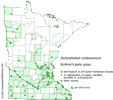 |
| National distribution (click map to enlarge): |  |
Pick an image for a larger view. See the glossary for icon descriptions.
Detailed Information
Flower: 

![[photo of panicle]](/udata/r9ndp23q/grass/dichanthelium-scribnerianum_0531_145642-t.jpg) Branching cluster 2 to 4 inches long at the top of the stem, the slender, wiry branches spreading to ascending, with a few spikelets (flower clusters) per branch and up to 60 spikelets in a panicle. Spikelets are stalked, 2.5 to 3.5 mm (to ~1/8 inch) long, broadest near the tip, and have 2 florets but appear single-flowered. In summer to fall, few-flowered secondary panicles may form in the lower and mid-stem nodes that may be at least partially hidden in the sheaths.
Branching cluster 2 to 4 inches long at the top of the stem, the slender, wiry branches spreading to ascending, with a few spikelets (flower clusters) per branch and up to 60 spikelets in a panicle. Spikelets are stalked, 2.5 to 3.5 mm (to ~1/8 inch) long, broadest near the tip, and have 2 florets but appear single-flowered. In summer to fall, few-flowered secondary panicles may form in the lower and mid-stem nodes that may be at least partially hidden in the sheaths.
![[close-up of panicle branches]](/udata/r9ndp23q/grass/dichanthelium-scribnerianum_0616_154255-t.jpg) At the base of a spikelet is a pair of bracts (glumes), both hairless to sparsely hairy, the lower glume about 1/3 as long as the spikelet, blunt to pointed at the tip, the upper glume as long as the spikelet, strongly veined, blunt to pointed at the tip, usually with a purple or orange spot at the base. Surrounding a floret is a pair of bracts (lemma and palea), the lower lemma like the upper glume and sterile, the lower palea about half as long, translucent whitish. The upper lemma is fertile, slightly shorter than the upper glume, shiny and hardened, blunt to rounded at the tip, the edges rolled around the edges of the similar palea.
At the base of a spikelet is a pair of bracts (glumes), both hairless to sparsely hairy, the lower glume about 1/3 as long as the spikelet, blunt to pointed at the tip, the upper glume as long as the spikelet, strongly veined, blunt to pointed at the tip, usually with a purple or orange spot at the base. Surrounding a floret is a pair of bracts (lemma and palea), the lower lemma like the upper glume and sterile, the lower palea about half as long, translucent whitish. The upper lemma is fertile, slightly shorter than the upper glume, shiny and hardened, blunt to rounded at the tip, the edges rolled around the edges of the similar palea.
Leaves and stems: 


![[photo of sheaths]](/udata/r9ndp23q/grass/dichanthelium-scribnerianum_0608_105827-t.jpg) Stem leaves are alternate, ascending to spreading, flat, 2 to 4 inches (5 to 10 cm) long, up to ~½ inch (6 to 12 mm) wide, the largest leaves less than 10 times as long as wide, tapering to a pointed tip. The upper surface is hairless, the lower hairless to variously short-hairy. Along the edges near the base are usually sparse, long hairs that have a pimple-like base (papillose). In fall, a loose rosette of basal leaves is formed, the leaves similar but somewhat smaller than the stem leaves. Sheaths are hairless to variously covered with spreading to ascending papillose-based hairs, sometimes hairless on the surface but fringed with hairs along the edges.
Stem leaves are alternate, ascending to spreading, flat, 2 to 4 inches (5 to 10 cm) long, up to ~½ inch (6 to 12 mm) wide, the largest leaves less than 10 times as long as wide, tapering to a pointed tip. The upper surface is hairless, the lower hairless to variously short-hairy. Along the edges near the base are usually sparse, long hairs that have a pimple-like base (papillose). In fall, a loose rosette of basal leaves is formed, the leaves similar but somewhat smaller than the stem leaves. Sheaths are hairless to variously covered with spreading to ascending papillose-based hairs, sometimes hairless on the surface but fringed with hairs along the edges.
![[photo of ligule]](/udata/r9ndp23q/grass/dichanthelium-scribnerianum-081217-s1-t.jpg) The ligule (membrane where the leaf joins the sheath) is a fringe of hairs 1 to 1.5 mm long.
The ligule (membrane where the leaf joins the sheath) is a fringe of hairs 1 to 1.5 mm long.
![[photo of nodes]](/udata/r9ndp23q/grass/dichanthelium-scribnerianum_0616_153929-t.jpg) Nodes are hairless to sparsely covered in short hairs. Stems are often purple and lustrous, hairless to sparsely hairy, a few from the base forming small clumps, usually prostrate from the base and rising at a lower node (geniculate), becoming erect to ascending. Late fall stems typically have a tight clump of leaves near the tip, sometimes 2, and can persist to the next season.
Nodes are hairless to sparsely covered in short hairs. Stems are often purple and lustrous, hairless to sparsely hairy, a few from the base forming small clumps, usually prostrate from the base and rising at a lower node (geniculate), becoming erect to ascending. Late fall stems typically have a tight clump of leaves near the tip, sometimes 2, and can persist to the next season.
Fruit: 
![[photo of mature spikelets and florets]](/udata/r9ndp23q/grass/dichanthelium-scribnerianum-220629-s3-t.jpg) The whole spikelet drops away when mature, leaving a naked stem behind. Grains (seeds) are enclosed within the persistent fertile lemma and palea.
The whole spikelet drops away when mature, leaving a naked stem behind. Grains (seeds) are enclosed within the persistent fertile lemma and palea.
Notes:
Dichanthelium, formerly lumped with Panicum, are cool-season grasses with two different bloom periods. The primary bloom is a terminal panicle in spring, the secondary is auxiliary panicles in summer into fall, during which time a rosette of basal leaves may also form. The two forms can be very different from each other; spring identification is more reliably consistent but this is still a difficult genus.
Dichanthelium scribnerianum is one of the more common species in Minnesota, most often found in open dry sandy prairies, grassy slopes, bluffs and rock outcrops, though it tolerates a range of conditions and has thrived in my garden in seasonally moist loam over clay. It is distinguished by its clump-forming habit; leaves ascending to spreading, up to about ½ in wide, less than 10 times as long as wide, hairless on the upper surface and usually sparsely papillose hairy along the edge near the base; ligule of hairs 1 to 1.5 mm long; panicle with ascending to spreading branches and up to 60 spikelets; spikelets 2.5 to 3.5 mm long, broadest near the tip, the lower glume less than half as long as the spikelet, the upper glume with a spot of purple or orange at the base. The secondary bloom is from the lower and mid-stem nodes and branches where the panicles may be only partially emerged; basal leaves are like stem leaves but somewhat smaller. Overall hairiness can be quite variable, not just between plants but between upper and lower portions of the same stem. The purple or orange spot at the base of the upper glume is a good starting point.
The taxonomy of D. scribnerianum has been batted back and forth between being a distinct species and a subspecies/variety of Dichanthelium oligosanthes (or Panicum oligosanthes, subsp/var scribnerianum). As of this writing we are following the latest treatment by J.R. Thomas, which splits them. D. oligosanthes has somewhat narrower (5 to 8 mm wide) leaves, proportionately longer, the largest leaves more than 10 times as long as wide, larger spikelets (3.5+ mm long), ligule hairs 2 to 3 mm long, and late season stems have 2 or 3 tight clumps of leaves. Habitats also differ, with D. oligosanthes preferring wooded areas in part or full shade. The national ranges of these two are not adequately mapped at this time.
D. leibergii has a somewhat similar form but hairs on spikelets and leaf surfaces are longer and all have papillose bases, its ligule is membranous and not more than .5 mm long, and the lower glume is half (or more) as long as the spikelet.
Native Plant Nurseries, Restoration and Landscaping Services ↓
More photos
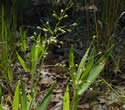 Dichanthelium scribnerianum plants
Dichanthelium scribnerianum plants Dichanthelium scribnerianum plants
Dichanthelium scribnerianum plants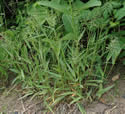 Dichanthelium scribnerianum plants
Dichanthelium scribnerianum plants Dichanthelium scribnerianum in sandy prairie
Dichanthelium scribnerianum in sandy prairie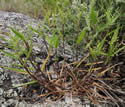 Dichanthelium scribnerianum in a rock outcrop
Dichanthelium scribnerianum in a rock outcrop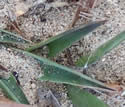 basal leaves in late fall
basal leaves in late fall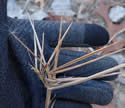 late fall stem with a clump of leaves at the tip
late fall stem with a clump of leaves at the tip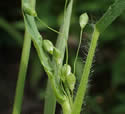 auxiliary panicles are smaller and often partially enclosed in the sheath
auxiliary panicles are smaller and often partially enclosed in the sheath
Photos by K. Chayka taken in Anoka and Ramsey counties. Photos by Peter M. Dziuk taken in Yellow Medicine County.
Comments
Have you seen this plant in Minnesota, or have any other comments about it?






